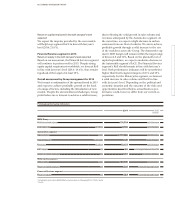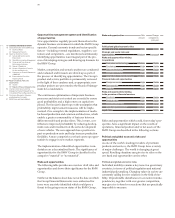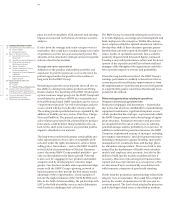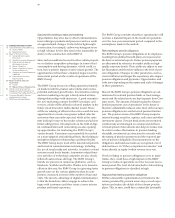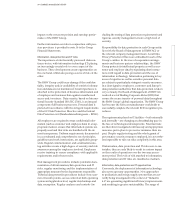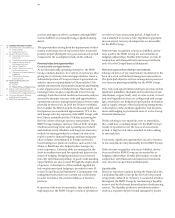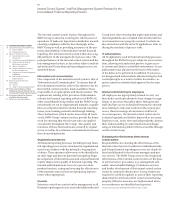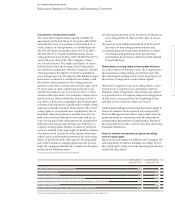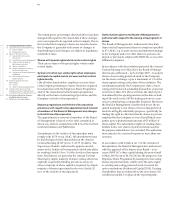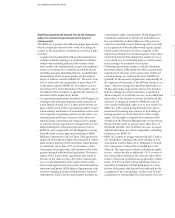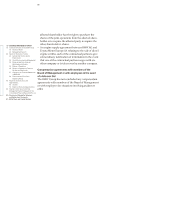BMW 2014 Annual Report Download - page 78
Download and view the complete annual report
Please find page 78 of the 2014 BMW annual report below. You can navigate through the pages in the report by either clicking on the pages listed below, or by using the keyword search tool below to find specific information within the annual report.
78
18 COMBINED MANAGEMENT REPORT
18
General Information on the
BMW
Group
18 Business Model
20 Management System
23 Report on Economic Position
23 General and Sector-specific
Environment
26 Overall Assessment by Management
26
Financial and Non-financial
Performance Indicators
29 Review of Operations
49 Results of Operations, Financial
Position and Net Assets
61 Comments on Financial Statements
of BMW AG
64 Events after the End of the
Reporting Period
65 Report on Outlook, Risks and
Opportunities
65 Outlook
70 Report on Risks and Opportunities
82 Internal Control System and Risk
Management System Relevant for
the
Consolidated Financial Reporting Process
83 Disclosures Relevant for Takeovers
and Explanatory Comments
87
BMW Stock and Capital Markets
s ervices and apps on offer to customers through BMW
ConnectedDrive is constantly being expanded and up-
dated.
The opportunities arising from the deployment of infor-
mation technology are not expected to have a material
positive impact during the two-year assessment period
compared to the assumptions made in the outlook.
Financial risks and opportunities
Currency risks and opportunities
As an internationally operating enterprise, the BMW
Group conducts business in a variety of currencies, thus
giving rise to currency risks and opportunities. Since a
substantial portion of Group revenues is generated out-
side the eurozone (particularly in China and the USA)
and the procurement of production material and funding
is also organised on a worldwide basis, fluctuations in
exchange rates can play a significant role for Group
earnings. Cash-flow-at-risk models and scenario analyses
are used to measure currency risks and opportunities.
Operational currency management is based on the results
provided by these tools. In 2014 the Chinese renminbi,
the US dollar, the British pound, the Russian rouble and
the Japanese yen constituted approximately 75 % of the
total foreign currency exposure of the BMW Group, with
the Chinese renminbi and the US dollar accounting for
the lion’s share of foreign currency transactions. The
BMW Group manages currency risks at both strategic
(medium and long term) and operating level (short
and
medium term). Medium- and long-term measures
include increasing production volumes in non-euro-
region countries (natural hedging) and increasing
pur-
chase volumes denominated in foreign currencies.
Constructing new plants in countries such as the USA,
China or Brazil have also helped reduce foreign
cur-
rency exposures. Currency risks are managed in the
short to medium term and for operational purposes by
means of hedging. Hedging transactions are entered
into only with financial partners of good credit standing.
Opportunities are also secured through the deployment
of options. A description of the methods applied for
risk measurement and hedging is provided in note 43
to the Group Financial Statements. Counterparty risk
management procedures are carried out continuously
in order to monitor the creditworthiness of business
partners.
If currency risks were to materialise, they could have a
high
impact on the BMW Group’s results of operations
over the two-year assessment period. A
high level of
risk is attached to currency risks. Significant
opportuni-
ties can arise if currency developments are favourable
for the BMW Group.
If the relevant recognition criteria are fulfilled,
deriva-
tives used by the BMW Group are accounted for as
hedging relationships. Further information on risks in
conjunction with financial instruments is provided in
note 43 to the Group Financial Statements.
Risks and opportunities relating to raw materials
Changes in prices of raw materials are monitored on the
basis of a set of well-defined management procedures.
The principal objective of these management processes
is to increase planning reliability for the BMW Group.
Price risks and opportunities relating to precious metals
(platinum, palladium, rhodium) and non-ferrous metals
(aluminium, copper, lead), and, to some extent, to steel
and steel ingredients (iron ore, coking coal) and energy
(gas, electricity) are hedged using financial derivatives
and / or supply contracts with fixed pricing arrangements.
A description of the methods applied for risk
measure-
ment and hedging is provided in note 43 to the Group
Financial Statements.
If risks relating to raw materials were to materialise,
they could have a medium impact on the BMW Group’s
results of operations over the two-year assessment
period. A high level of risk is attached to risks relating
to raw materials.
Conversely, significant opportunities can arise if prices
of raw materials develop favourably for the BMW Group.
If the relevant recognition criteria are fulfilled, deriva-
tives used by the BMW Group are accounted for as
hedging relationships. Further information on risks in
conjunction with financial instruments is provided in
note 43 to the Group Financial Statements.
Liquidity risks
Based on experience gained during the financial crisis,
a minimum liquidity concept has been developed and
is rigorously adhered to. Solvency is assured at all times
throughout the BMW Group by maintaining a liquidity
reserve and by the broad diversification of refinancing
sources. The liquidity position is monitored continu-
ously at a separate entity level and managed by means



